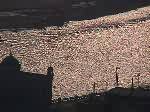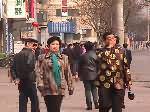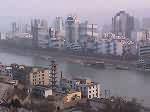- Getting around Lijiang. Dont stay in the Old Towns more than 2 days, there is nothing to do. KRISS Oct 9, 2013 05:46
- 2013 Beijing Temple Fair BENNYLAU Feb 26, 2013 03:29
- Malaysian traveling from KUL - LAX vis Shanghai PVG ZATI_DY Jan 3, 2013 20:15
Brushing Against Silk - A Taste of the Silk Road in Lanzhou
- Views: 5042
- |Vote: 3 0
- |Add to Favorites
- |Recommend to Friends
Caravans
You’ve heard of the Silk Road – the ancient trading route leading west out of China that for centuries was the path along which silk was brought out and into the Western Lands, entering markets as far away as Europe. For many Westerners, the Silk Road conjures up images of great caravans of camels and men wrapped in cloth, plodding across the desert wasteland, and on the backs of the camels, dazzling stacks of multi-coloured silks, a material so ahead of its time that is was a total mystery to those purchasing it, just another piece of Chinese wizardry.
Some travellers follow the old route right up into Xinjiang, formerly known as Chinese Turkestan, where they’ll get familiar with the Middle East within the borders of China and begin to have an appreciation for the diversity of cultures within this one nation. But most travellers don’t quite get that far – distances in China’s West become harder and harder to cross by yourself – and for the average traveller it’s time consuming enough to make your way around the Eastern parts of the country. But for those who do make it out to the Road, it’s hard to underestimate the treat in store for you...
For those who are just looking for a taste of that Silk Road mystique, Lanzhou is a good choice of destination. It’s an overnight train ride away from Xi’an, it’s right on the Yellow River, and it’s an extraordinary cross between Islamic and Han Chinese culture.
Through the City
I arrived in Lanzhou quite early in the morning, and was quite struck by the lack of people. The sun seemed to be taking a while to make the day bright, and I wandered out from the train station in near solitude, most unusual for a Chinese town. The station was bare, and behind it in the dim I could just make out the shape of some enormous mountains that seemed to function as a southern blockade for the city, and which continued to give that impression throughout my stay.
Lanzhou is, in fact, quite tightly tucked in to the banks of the Yellow River – not only do the southern mountains restrict its expansion in that direction, but a sharp rise on the northern bank has ensured that as Lanzhou has developed, it has expanded only along the long, straight path of the river. As a result, Lanzhou on the map looks like a piece of string, a city that is massively wide but without any length North and South.
Lanzhou’s major development has really only been in the last 50 years since liberation, but that development has been rapid and pronounced, and Lanzhou has consequently reached a size quite respectable for its status as the capital of Gansu province. Its industrialisation was likewise developed quickly and abruptly, and it is for this reason that Lanzhou has, in the past, been called one of China’s most highly polluted areas and dirtiest capitals. That was then, this is now: Lanzhou’s cleaned itself up quite remarkably in the last decade or so, and its economic development has given the central areas a brand new face. When I walked through the roads in the morning from the train station, I found the streets to be tidy, the air to be dry and reasonably clean, and on the whole, I felt that Lanzhou seemed a thoroughly likeable town. There was, of course, a lot more exploration to be done, and I set about the task.
First, however, came the problem of accommodation. My guidebook told me to head directly north to the Xiguan Traffic Circle, described as one of the ‘centres of town’. In this respect, it was quite wrong. The Traffic Circle was a regular roundabout, and there was really nothing there, although on the Northwestern side the Lanzhou Hotel was the only establishment I could convince to allow accommodation of a foreigner, at 120 yuan a night.
A walk westwards along one of Lanzhou’s main roads revealed that the main central area is in the mid-east around Zhongshan Road. I was trying to find some people – there still didn’t seem to be anyone around – and a temple I’d read about called the Baiyi Si. It was supposed to be on the roadside, but I walked past it a few times before I spotted it for what it was. For a start, it was closed, and secondly, it didn’t really seem to me to be a temple – there were no signs at all, and from what I could make out, it looked more like a library. I did manage to spot the temple’s real attraction out the back, though – a pagoda that dates back to the 1400’s – it had an odd, tapering quality that I couldn’t quite see clearly from the road, and so I did regret whatever change it had been to close the place down.
By the time I reached Zhongshan Rd, the crowds had started to thicken and I felt at last amongst real people. With a population of only three million, Lanzhou is remote enough in feel to give the impression of being as far from Beijing as it actually is, but just populous enough to allow a concentration of modern city luxuries. There’s a cafe in the middle of town that is an unashamed close copy of Starbuck’s (which sells coffee that is actually better) and there are malls and towers of glass and everything you’d expect from a place of its like. The people wandering past me had that faraway look about them, as if they were always dwelling on something other than just where they were going, and were dressed darkly in black suit pants and black leather jackets, the occasional middle aged woman in a faded qipao.
The Dragon and the Lion
The best part of the visit, and undoubtedly the most interesting part of Central Lanzhou, was the point where I reached the river’s edge at the Yellow River Iron Bridge. The bridge spans the river in a short row of six simple iron arches, and the Yellow River itself quietly rushes beneath it, a steady terracotta-coffee coloured flow on its way across the country up beneath Mongolia, taking a sharp turn south to Henan, and then out to the Yellow Sea via Shandong. You could throw a bottle off the bridge and it could carry all the way to the Pacific Ocean; yet standing above the river, one couldn’t feel further away from the sea. Despite its modern look, there’s still very much the feel of the desert over Lanzhou – the Gobi reaches right to the edge of town – and at the bridge, this feeling is accentuated by the stark contrast of cultures at either end. The South Bank of the river, where I’d just spent the morning, is very much a thriving and developing Han Chinese capital – behind me, I could see towers of concrete with glass window facades, giant billboards with huge Chinese characters and pop stars from Hong Kong. But the North Bank resembles something from another country entirely, even of another age.
North of the Yellow River is Lanzhou’s main Hui settlement, China’s Islamic minority ethnic group, and the area couldn’t look more like a little Arab town. Little square stone huts in clusters backed up the steep slope, seeming to overlap and clutter over each other, and the sun shone over them with the mustard colour of desert sands and river clay. Hui Chinese in white skull caps wandered past lazily in the sunshine, and old men sitting against the walls of their homes stared at me with the desert in their strange, hazel eyes.
On the slope above the settlements, a public park reaches up to the top of the pass, where little pathways and pavilions have been set out in traditional Qing period Chinese style to enclose the central attraction, the white pagoda – a tower that has stood above the Yellow River throughout Lanzhou’s history. Wandering through the park was relaxing, but I had to admit that even when I reached the pagoda, my attention was drawn more to the view over the river than to the park itself. From that elevation, the contrast between North & South was even more obvious. It was beautiful – the Han, developed part of town was cast in blue like a jewel: the Hui side ochre and dusty and profoundly austere. The spires of mosques broke out of the housing settlements, white towers with pinnacles of emerald. I heard singing, that unmistakable Arabic lilting, melodies as old as Persia and Babylon.
After the sun fell into the river in the West, I slowly made my way back through the town, but when I got back to my hotel at last, I was reluctant to go in and kept walking. Soon I was immersed in the back streets just north of the train station, and I was glad I’d come out. Lamplight was scarce, and the street had taken on the characteristic of a campfire: in the blackness, the shapes of shirtless men flickered around short tables, bottles of beer in their grasp and pulling at the roast meats on skewers with their teeth. There were Han Chinese present, but the atmosphere was undoubtedly Arabic, and the light in men’s eyes was the light of the caravans and the Gobi, and centuries of Muslim traders making their own culture a part of China, bringing together forever the ancient dragon of jade and lion of the sands.






 Copyright © 1998-2025 All rights reserved.
Copyright © 1998-2025 All rights reserved.